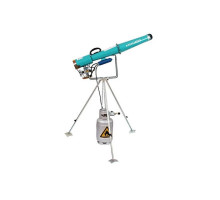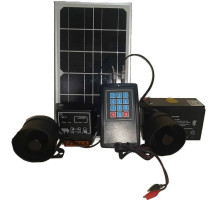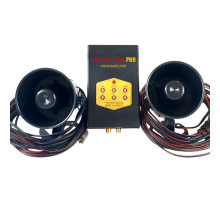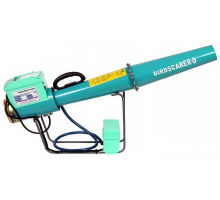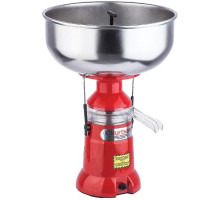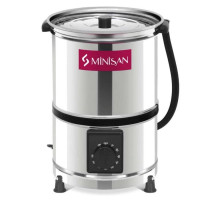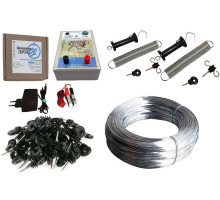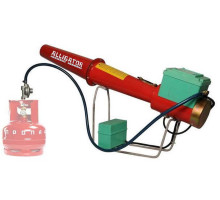Birds and wild animals are undoubtedly an important part of the ecosystem, but their presence on agricultural lands, warehouses, homesteads or even on the roofs of buildings often leads to serious problems. From destroying crops and damaging property to spreading diseases and creating noise - unwanted feathered and four-legged guests can cause significant damage. Fortunately, the modern market offers a wide range of bird and animal repellents that allow you to humanely and effectively solve this problem. Choosing the right bird repeller or animal repeller is the key to successful pest control . In this article, we will take a closer look at the main types of repellers, their advantages, disadvantages and application features.
Why are repellents needed? Understanding the problem
Before choosing an animal or bird repeller , it is important to understand the scale of the problem:
- Agriculture: Birds (starlings, sparrows, crows, pigeons) can destroy a significant part of the harvest of berries, fruits, and grains. Wild animals (hares, wild boars, foxes) damage crops, seedlings, and root crops. Protecting the harvest from birds and animals is a top priority for farmers.
- Urban environment and private homes: Pigeons and other birds litter buildings, monuments, cars, create noise, can damage roofs and ventilation systems. Rodents, cats, dogs can spoil property, lawns, create unsanitary conditions. A rodent repeller for the house or a cat repeller for the garden become a necessity.
- Industrial facilities and warehouses: Birds can nest indoors, contaminate produce, and damage equipment. Rodents are a serious threat to food supplies and the integrity of packaging. Protecting a warehouse from pests requires a comprehensive approach.
Types of repellers: which one to choose?
There are many technologies and methods of scaring. Let's consider the most popular and effective scarers .
1. Acoustic (Bioacoustic) repellers
These devices play sounds that are unpleasant or frightening to specific species of birds or animals.
- Principle of operation: Imitation of the cries of birds of prey (hawks, falcons, owls) or alarm signals of the pest birds themselves (for example, an acoustic crow repeller or a bioacoustic starling repeller ).
- Advantages:
- Highly effective against certain bird species.
- Large coverage area (up to several hectares for professional models).
- A humane method that does not cause physical harm.
- Disadvantages:
- Can create noise pollution for people and pets.
- Birds can get used to monotonous sounds over time (it is important to choose models with varied and random signals).
- Efficiency may depend on terrain and obstacles.
- Where and how to place: On hills, in the center of the protected area, directing the speakers in the right direction. For large areas (fields, gardens, vineyards) several devices may be needed. Ideal for open spaces.
2. Ultrasonic repellers
They generate high-frequency sound waves that are inaudible to humans, but extremely unpleasant to many animals and some birds.
- Principle of operation: Ultrasound creates an uncomfortable environment that forces pests to leave the area of action of the device. Often used as an ultrasonic animal repeller , including a rodent repeller , a dog repeller , a cat repeller , and a mole repeller (often in the form of pins dug into the ground, sometimes on a solar battery ).
- Advantages:
- Silent for people.
- Compact and easy to install.
- Safe for the environment.
- Wide range of animals repelled (depends on model and frequency).
- Disadvantages:
- Limited range of action.
- Ultrasound does not pass well through walls, fences, and dense vegetation.
- Effectiveness against birds is often lower than that of acoustic models.
- Some animals (especially young or old) may have reduced sensitivity to ultrasound.
- Where and how to place: near pest activity areas (burrows, trails, feeding areas, home entry areas). Indoors, point to open space. Outdoors, consider barriers. Multiple devices may be required to protect a perimeter.
3. Visual deterrents
Visual stimuli are used to scare away birds.
- Principle of operation: Imitation of predators (model owls, hawks), shiny and moving objects (ribbons, balls with eyes, spirals), scarecrows.
- Advantages:
- Simplicity and low cost.
- Silence.
- Environmental friendliness.
- Good as a visual deterrent for a garden or small vegetable patch.
- Disadvantages:
- Birds quickly get used to static objects (it is necessary to periodically change their location or use dynamic models).
- Efficiency is often lower than that of sound or other active systems.
- They work best in combination with other methods.
- Where and how to place: In places where birds congregate – on tree branches, roofs, fences, flower beds. Ensure good visibility and movement (for dynamic models).
4. Propane Repellents (Thunder Guns)
Powerful devices that create very loud bangs that simulate gunshots.
- Principle of operation: Periodic explosion of a propane-air mixture in the barrel of the gun. The sound pressure effectively scares away birds and wild animals from large areas.
- Advantages:
- Extremely high efficiency in large open spaces (fields, airfields, landfills).
- Huge coverage area (up to 5-7 hectares or more).
- Reliable crop protection from birds and large animals.
- Disadvantages:
- Very high noise level (may require approval from neighbors and local authorities).
- Requires regular propane refueling.
- Relatively high cost.
- Animals may become accustomed to it if used too frequently and monotonously (it is important to set the intervals and random mode).
- Where and how to place: In the center of large fields or gardens, at a safe distance from residential buildings and places where people/pets live. Install on a stand or tripod for better sound distribution. If you are looking for where to buy a field bugle , pay attention to models with adjustable intervals and cotton strength.
5. Laser repellers
Modern devices that use a laser beam to disorient and scare birds.
- How it works: A moving laser beam (usually green) is perceived by birds as a physical threat or predator, forcing them to leave the area.
- Advantages:
- Silent operation.
- High efficiency, especially in low light conditions (dusk, dawn, indoors).
- Long range (professional models).
- Birds do not get used to the laser as quickly as they do to other methods.
- Disadvantages:
- High price of laser bird repeller .
- Direct visibility is required, effectiveness is reduced in bright sunlight.
- It is necessary to avoid the beam getting into the eyes of people and animals.
- Less effective against terrestrial animals.
- Where and how to place: Optimal for large spaces (warehouses, hangars), roofs, fields in the morning/evening hours. Install so that the beam covers the maximum area, avoiding direct light onto roads or windows of residential buildings.
6. Other methods (Briefly)
- Physical barriers: Nets, spikes, strings – prevent birds from landing on certain surfaces (window sills, cornices, monuments). Effective, but local.
- Repellents: Chemicals with an unpleasant odor or taste to birds/animals. Limited use, require reapplication, can be dangerous.
How to choose and place a repeller correctly?
Choosing the optimal bird and animal repeller depends on several factors:
- Different species respond to different types of repellents (ultrasound is better for rodents and dogs, bioacoustics for crows and starlings, thunder - cannon - for all birds and large animals in the fields).
- Area size: Visual or ultrasonic models are suitable for a small garden, acoustic or propane models for a field of several hectares.
- Location: Near residential buildings, ultrasonic or laser are better than loud acoustic or propane. The presence of obstacles (buildings, trees) reduces the effectiveness of ultrasonic and lasers.
- Budget: Prices range from inexpensive visual repellers to professional laser or propane systems.
- Integrated approach: Often the best result is obtained by combining several methods (e.g. acoustic + visual).
- Correct placement: Always follow the manufacturer's instructions. Position the device so that it covers the problem area. Change the location periodically (if possible) to avoid habituation.
Where to buy effective repellents in Ukraine?
Finding a reliable supplier of professional bird repellers is an important step. If you are looking for where to buy a bird repeller in Ukraine or need an effective solution for protection against rodents, dogs, cats or wild animals, we recommend that you pay attention to specialized stores that offer proven products and expert advice.
One of these reliable suppliers is the Gontagro online store. It offers a wide range of different types of repellers - from ultrasonic and acoustic to powerful propane guns and modern laser systems. You will be able to choose the optimal solution for your needs, whether it is the protection of a small summer cottage or large agricultural land.
You can view the catalog and get advice at the link:
The store's specialists will help you choose an animal or bird repeller based on your specific situation and will offer the most effective repeller at a reasonable price.
Conclusion
Fighting unwanted birds and animals requires a thoughtful approach. Modern bird and animal repellers offer humane and effective solutions to protect your property, crops and peace of mind. Understanding the principles of operation of different types of devices, their advantages and disadvantages, as well as taking into account the characteristics of your territory and the type of pest, you will be able to make the right choice. Do not forget about the possibility of combining methods and the importance of proper placement of devices. And you can always buy a quality repeller from trusted manufacturers in specialized stores, such as Gontagro. Protect your property effectively and safely!







